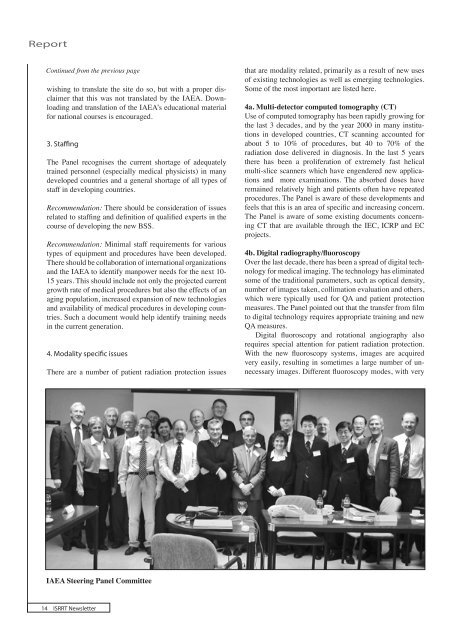ISRRT_August_2006
You also want an ePaper? Increase the reach of your titles
YUMPU automatically turns print PDFs into web optimized ePapers that Google loves.
Report<br />
Continued from the previous page<br />
wishing to translate the site do so, but with a proper disclaimer<br />
that this was not translated by the IAEA. Downloading<br />
and translation of the IAEA’s educational material<br />
for national courses is encouraged.<br />
3. Staffing<br />
The Panel recognises the current shortage of adequately<br />
trained personnel (especially medical physicists) in many<br />
developed countries and a general shortage of all types of<br />
staff in developing countries.<br />
Recommendation: There should be consideration of issues<br />
related to staffing and definition of qualified experts in the<br />
course of developing the new BSS.<br />
Recommendation: Minimal staff requirements for various<br />
types of equipment and procedures have been developed.<br />
There should be collaboration of international organizations<br />
and the IAEA to identify manpower needs for the next 10-<br />
15 years. This should include not only the projected current<br />
growth rate of medical procedures but also the effects of an<br />
aging population, increased expansion of new technologies<br />
and availability of medical procedures in developing countries.<br />
Such a document would help identify training needs<br />
in the current generation.<br />
4. Modality specific issues<br />
There are a number of patient radiation protection issues<br />
that are modality related, primarily as a result of new uses<br />
of existing technologies as well as emerging technologies.<br />
Some of the most important are listed here.<br />
4a. Multi-detector computed tomography (CT)<br />
Use of computed tomography has been rapidly growing for<br />
the last 3 decades, and by the year 2000 in many institutions<br />
in developed countries, CT scanning accounted for<br />
about 5 to 10% of procedures, but 40 to 70% of the<br />
radiation dose delivered in diagnosis. In the last 5 years<br />
there has been a proliferation of extremely fast helical<br />
multi-slice scanners which have engendered new applications<br />
and more examinations. The absorbed doses have<br />
remained relatively high and patients often have repeated<br />
procedures. The Panel is aware of these developments and<br />
feels that this is an area of specific and increasing concern.<br />
The Panel is aware of some existing documents concerning<br />
CT that are available through the IEC, ICRP and EC<br />
projects.<br />
4b. Digital radiography/fluoroscopy<br />
Over the last decade, there has been a spread of digital technology<br />
for medical imaging. The technology has eliminated<br />
some of the traditional parameters, such as optical density,<br />
number of images taken, collimation evaluation and others,<br />
which were typically used for QA and patient protection<br />
measures. The Panel pointed out that the transfer from film<br />
to digital technology requires appropriate training and new<br />
QA measures.<br />
Digital fluoroscopy and rotational angiography also<br />
requires special attention for patient radiation protection.<br />
With the new fluoroscopy systems, images are acquired<br />
very easily, resulting in sometimes a large number of unnecessary<br />
images. Different fluoroscopy modes, with very<br />
IAEA Steering Panel Committee<br />
14 <strong>ISRRT</strong> Newsletter


















